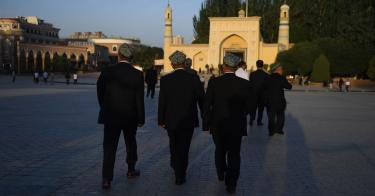The Chinese government has arbitrarily detained more than 1 million Muslims in its western region of Xinjiang. But the ramifications of this crisis extend well beyond Xinjiang. Beijing’s repressive use of surveillance technology threatens not only the fundamental freedoms of its detainees, but that of individuals across the globe. It threatens U.S. national security, as well.
Beijing’s actions merit a swift and strong response, one that uses the traditional tools of foreign policy and recognizes the relative importance the Chinese government places on exerting control over Xinjiang.
China has deployed surveillance technology in Xinjiang to track the Muslim population’s every move. By reverse-engineering the IJOP application Chinese police use to track Uighurs, Human Rights Watch found that even innocuous actions like leaving one’s home via the back door rather than the front are deemed suspicious.
It is this application that enabled the Chinese government to so expeditiously intern large swaths of the Uighur population. And Beijing is already exporting this application, along with other forms of surveillance, to places like Africa and South America.
At a recent event at The Heritage Foundation, Nury Turkel, chairman of the Uighur Human Rights Project, noted:
"The Chinese government is using the Uighurs life and their homeland as a laboratory for the surveillance state."
Turkel went on to explain how more than 18 countries, including first-world democracies like Germany, are already using—or receiving training in how to use—surveillance technology from the Chinese government or Chinese state-owned enterprises (SOEs).
The African case is particularly egregious. The Chinese government exported a surveillance technology produced by a Chinese SOE to the Zimbabwean government, which not only uses the technology to spy on its own citizens, but also permits the Chinese SOE access to the private data of its citizens in order to refine its technology for use on “darker skin tones.”
Beyond this, a Chinese SOE won the bid to build the African Union’s headquarters, where the SOE allegedly lined the walls of AU headquarters with microphones and received nightly downloads from the AU’s servers from 2012 to 2017. In other words, the Chinese government is using surveillance technology to equip other bad actors, as well as to collect intelligence for its own gains.
But back to Xinjiang.
Events unfolding there—mass collectivization, reports of forced labor, torture, and re-education—bear a striking resemblance to the repression carried out during the Cultural Revolution to reorient the ordinary lives of the Chinese people around core tenets of the Chinese communist party.
However, unlike the Cultural Revolution, the Chinese government today is armed with emerging technology that both streamlines and expedites its ability to repress its citizens.
In the face of such severe threats to national security, sovereignty, and freedom, the U.S. government must act. At a recent event hosted by The Heritage Foundation, Heritage analysts released a new paper laying out a roadmap to respond to the crisis in Xinjiang.
Some of the next steps outlined in the paper include: sanctioning Chen Quanguo, a top official who is the primary architect of China’s high-tech surveillance state; increasing pressure on businesses to discontinue exporting dual-use technology to the Chinese government, and putting pressure on Beijing to release all prisoners from the political re-education facilities.
These are merely first steps. Many more should be taken to stem the tide of further abuses against China’s Muslim population.
As a leader in the international community, the U.S. must send an unequivocal signal that it stands for freedom and that countries who repress fundamental freedoms will be held to account. Prioritizing responding to Xinjiang is the right way for the U.S. to take a stand for liberty in Asia.
This piece originally appeared in Forbes https://www.forbes.com/sites/oliviaenos/2019/06/18/why-the-crisis-in-xinjiang-is-about-more-than-human-rights/#374c456a6c77



